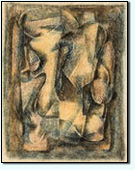Gouaches (1961-1966)
Museum-Gallery Collection
We read everything on pre-Cortez times that we could find. Prescott's history of the conquest of Mexico and Peru; Bernal Diaz del Castillo, who described so quaintly and so graphically the country and the people and the details of the coming of the Spaniards, as one of Cortez' men; more recent writers on the culture of the Aztecs, the Mayans, the Incas. Also general mythology such as the Golden Bough, poetry such as The White Pony, an anthology of Chinese poetry from 1100 B.C. through 1921. All this fired Ary's imagination, and what with improved physical condition, greater peace of mind, and new stimuli to inspire him, Ary's incredibly rich imagination began to reassert itself. Now, he fantasized, he had discovered through excavating among ancient ruins, a "palace of the prince" and everything that poured forth as he sat in the arm-chair in the corner of the verandah was something he carried away from the walls of this ancient palace. So in 1960 he began a series of gouaches, which in creativeness, in spontaneity, in line and form are perhaps the culmination, or at least the beginning of the culmination of his entire career as a non-representational painter. Ary felt that himself, "I am a new Ary" he would say. He even decided that this new Ary should have his name on the paintings rather than the old Stillman whose depression he had fought off. So one will find that practically all of the gouaches and many of the later canvases bear the name "Ary." Later on, after we left Mexico, he drifted back into signing "Stillman" again.

Red, Yellow and Blue
c.1961-1966,
gouache on paper,
13 x 18 in.,
[Museum Collection]





















